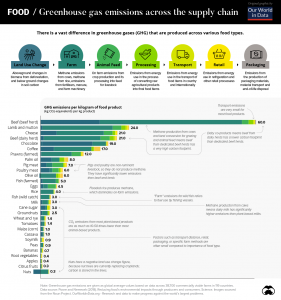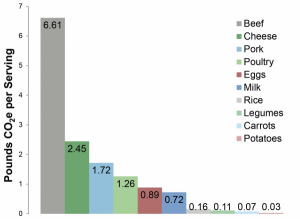Reducing Food Industry Carbon Emissions Through Eco-Labels and More
Written by: Erin Yoo
Panera, McDonald’s, Burger King, and Wendy’s are some of the biggest fast-food names in corporate America and daily life around the world. However, despite their world-famous yummy meals, their huge presence is also the cause of another important reality: climate change. Fast food cattle farms and manufacturing practices produce unbelievable amounts of carbon dioxide, methane, nitrous oxide, and other greenhouse gases. In turn, consumer demand for their rapidly-prepared, familiar meals propels environmental degradation. One solution that a handful of food companies have tried to implement is “climate impact labels” to make customers more aware of the environmental impact they have through their consumer habits. When customers go to order meals the impact of buying that food item can easily be seen and understood by the customer — at least that’s the goal.
Eco-Label Pioneers
One of the first companies to implement environmental impact labels onto its products was PepsiCo, who posted carbon emission levels onto its potato chip bags in 2007. However, without other products to compare to, most buyers didn’t pay attention to the labels which were then discontinued (Giles, 2020b). Thirteen years later, in January 2020, Quorn, a meat substitute company, announced it would start providing in-depth information about the carbon emission levels associated with menu items as did Just Salad, a salad company, just a couple months later (Giles, 2020b; Kateman, 2020).
Following suit, Panera declared it would start utilizing “Cool Food” badges, which would indicate that a food item follows industry-recommended guidelines for carbon emissions, on its menu to help eaters make eco-friendlier decisions (Giles, 2020b). Similarly, Chipotle revealed they too would be adding greenhouse gas emission data labels to their nutrition labels for some of its menus (Giles, 2020a). These stickers are very important in helping consumer culture become eco-friendlier, since the food industry is currently detrimental to the environment.
How the Food Industry Impacts the Climate
Though climate change has closely been linked to images of pollution and dirty urban factories, the agricultural industry is actually the biggest source of greenhouse gas emissions (Pieper, 2020). Some reports even show how livestock agriculture alone causes 50% of emissions globally (“Food’s Carbon,” n.d.). Most everyone has heard about how cattle and other ruminants release methane into the atmosphere through their digestive system. But there are many other ways that greenhouse gases are released. Carbon dioxide is released through rotting material broken down by microorganisms, burning of plant waste, and soil agricultural methods (Pieper, 2020). It is also indirectly emitted through transportation, generation of heat for stables, and fertilizers (Pieper, 2020). Nitrogen fertilizer also releases nitrous oxide into the atmosphere (Pieper, 2020). Accumulation of these greenhouse gases then trap heat in the atmosphere, warming up the earth and causing climate change with devastating effects. Direct sources of emissions can be seen in each step of food production as seen in Figure 1.
Figure 1

Carbon emissions throughout the food supply chain process.
Source: Visual Capitalist
As seen in Figure 1 and Figure 2, animal-based foods are the most damaging to the Earth, having almost seventy times more social and environmental cost than plant-based foods (Pieper, 2020). For further context, the least damaging animal-based product releases more greenhouse gases throughout the food supply process than the most damaging plant-based product (Pieper, 2020). Out of the animal-based products, beef and lamb are especially damaging by a large margin. Thus, even just reducing the amount of consumed beef, rather than eliminating meat completely from diets, can greatly improve a consumer’s carbon footprint, or the impact they have on the environment (“Carbon Footprint,” 2020; Panzone, 2020).
One reason animal foods are so harmful is because of the inefficient conversion of feed to primary animal products. For example, forty to fifty pounds of cow fodder or feed results in just one pound of beef (Pieper, 2020). This also shows the incredible amount of resources necessary to support animals and produce animal foods, which is another factor for sky-high carbon emissions. Clearly, the data shows that dedicated actions towards reducing emissions are extremely crucial.
Figure 2

Effect of specific foods in terms of carbon dioxide equivalent emissions. This chart shows how animal-based products, particularly beef, are especially harmful to the environment by contributing the most amount of CO2e released into the atmosphere.
Source: University of Michigan Center for Sustainable Systems
Other Solutions
Besides adding more stickers onto food containers, organic farming is a different solution that has gained much attention for its products’ nutritional value and eco-friendly practices. For example, organic farmers can’t use mineral nitrogen fertilizers, which means less nitrous oxide is released into the atmosphere (Pieper, 2020). They also use organic feed, which is created from non-imported (more local), organic plant-based products that have a smaller carbon footprint than traditional feed through its production, transportation, and consumption (Pieper, 2020). However, it should be noted that organic farming is much more beneficial for cultivating plant products than animal products when compared to traditional farming methods (Pieper, 2020). In fact, organically grown eggs, poultry, and beef actually emit higher levels of greenhouse gases than their traditionally grown counterparts (Pieper, 2020)
Another possible solution is to utilize money as a tool for accountability by including real but often unseen outcomes of food production and consumption in the price of foods. One 2020 paper from the journal Nature Communications explains how this can be done: by quantifying the “external costs,” or social and environmental effects of food production and consumption, and then adding that quantity to food prices (Pieper, 2020). The scientific consensus on this quantification is that every ton of CO2 equivalents emitted or released should cost $181 (Pieper, 2020). Though, the cost would likely increase in future decades. (Carbon dioxide equivalent — CO2e — is a standard unit used to easily compare CO2, nitrous oxide, and methane levels (“Carbon Footprint,” 2020)). This would follow the “polluter-pays” principle developed by the United Nations and help consumers become more conscious about how their eating habits directly impact the natural world (Pieper, 2020). Increasing food costs would also theoretically mean less food would be thrown away, since appreciation for food would rise alongside the monetary value of it. Moreover, in the long run, healthcare spending would decline as overall individual health would improve with a cleaner environment (Pieper, 2020).
To those that may oppose higher prices for it being a burden on consumers, we are already paying for this extra cost in many ways through emergency weather aid and more. In fact, the same 2020 Nature Communications paper states that increasing overall food costs would be a fairer way to pay for environmental damage because those who make eco-friendlier eating decisions would not pay extra fees for harming the environment (Pieper, 2020). The extra profits could then go towards monetary incentives for farmers that implement sustainable farming practices (Pieper, 2020). At the same time, it is true that this specific method of making consumers more environmentally aware would negatively impact poorer families who already spend more of their income on food — thus, a compensation or other solution for this population is needed (Pieper, 2020).
Conclusion
Despite their huge benefits, climate impact labels have a long way to go. For example, Chipotle has faced some criticism for releasing somewhat misleading labels, because they easily led consumers to think they were buying carbon negative meals when they were just buying less harmful meals (Giles, 2020a). Even other solutions such as organic farming and increasing food prices have their flaws and are far from being the perfect solution for reducing carbon emissions in the food industry. Yet, the implications for these solutions are less controversial and are arguably a reason for optimism and hope (Giles, 2020a). In a largely capitalistic society, increasing the use of eco-labels, and possible other solutions, will hopefully help spur companies to compete against each other to create lower and lower impacts on the climate by reducing carbon emissions (Giles, 2020b). This will solve the problem PepsiCo ran into over a decade ago regarding its labels with lack of comparable data. With the help and power of some of the biggest names in the food industry and a few simple labels, climate change may become easier to fight.
References and Sources
Carbon Footprint Factsheet. (2020). Retrieved from http://css.umich.edu/factsheets/carbon-footprint-factsheet
Food’s Carbon Footprint. Retrieved from https://www.greeneatz.com/foods-carbon-footprint.html
Giles, J. (2020a, October). Nudging consumers the wrong way. Food Weekly, https://info.greenbiz.com/index.php/email/emailWebview
Giles, J. (2020b, October 23). Parsing Panera’s plan to nudge consumers toward low-carbon meals. GreenBiz. https://www.greenbiz.com/article/parsing-paneras-plan-nudge-consumers-toward-low-carbon-meals
Kateman, B. (2020, July 20). Carbon Labels Are Finally Coming To The Food And Beverage Industry. Forbes. https://www.forbes.com/sites/briankateman/2020/07/20/carbon-labels-are-finally-coming-to-the-food-and-beverage-industry/?sh=71feb90a7c03
Neufeld, D. (2020, February 10). The Carbon Footprint of the Food Supply Chain. Visual Capitalist. https://www.visualcapitalist.com/visualising-the-greenhouse-gas-impact-of-each-food/
Panzone, L., & Auch, N. (2020, January 7). Four ways to reduce the carbon in your food basket. The Conversation. https://theconversation.com/four-ways-to-reduce-the-carbon-in-your-food-basket-128811
Pieper, M., Michalke, A., & Gaugler, T. (2020). Calculation of external climate costs for food highlights inadequate pricing of animal products. Nature Communications, (11), 6117. https://sites.imsa.edu:2178/10.1038/s41467-020-19474-6